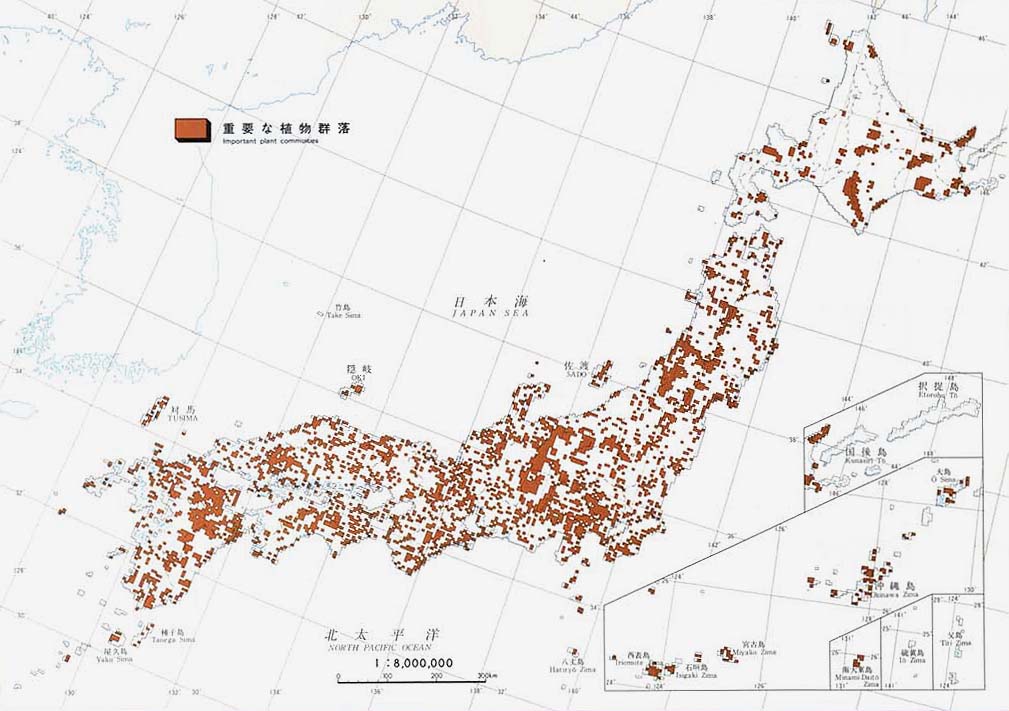
|
18.
|
重要な植物群落 IMPORTANT PLANT COMMUNITIES |
||
|
ここに掲載した植物群落は、わが国における植物群落のうちで、学術上重要なものや保護を必要とするものなどで、下にあげた選定基準により選定されたものである。具体的には、これらはその特異性、稀少性、典型性、自然性、歴史性、脆弱性において特徴をもち、代替性に乏しいものといえ、その分布や生育状況を把握し、保護していくことが必要とされる植物群落といえよう。選定されたカ所数は全国で3,833件にのぼり、面積では約935,000ヘクタールで、これは国土面積の約2.5%にあたる。 また、事例としてあげた植物群落の分布図は、「原生林もしくはそれに近い自然林」、「ブナ林」、「湿原」および「常緑広葉樹林」である。
A……原生林もしくはそれに近い自然林 B……国内若干地域に分布するが、きわめて稀な植物群落または個体群 C……比較的普通にみられるものであっても、南限、北限、隔離分布等分布限界になる産地にみられる植物群落または個体群 D……砂丘、断崖地、塩沼地、湖沼、河川、湿地、高山、石灰岩地等の特殊な立地に特有な植物群落または個体群で、その群落の特徴が典型的なもの E……郷土景観を代表する植物群落で、特にその群落の特徴が典型的なもの F……過去において人工的に植栽されたことが明らかな森林であっても、長期にわたって伐採等の手が入っていないもの G……乱獲その他人為の影響によって、当該都道府県内で極端に少なくなるおそれのある植物群落または個体群 H……その他、学術上重要な植物群落または個体群 |
On the map here are presented the locations of plant communities of scientific importance or in special need of protection. The criteria for selection of these plant communities are given at the end of this article; the communities selected are very unique and rare, highly typical and natural to their growing places, or of historical importance, but fragile. They can not be substituted by any other existing communities. It is necessary to understand their distribution and growing conditions to protect them. There are 3,833 communities covering an area of 935,000 hectares, which is equivalent to almost 2.5 per cent of our land area. The four maps on the following pages show the localities of selected examples of these important plant communities, which include primeval or quasi-primeval forests, beech forests, moors, and evergreen boardleaved forests.
Criteria of Selection A. Primeval forests or quasi-primeval natural forests. B. Plant communities or populations which are very rare, though found in several places within Japan. C. Plant communities or populations at their southern or northern limit of distribution, or those showing isolated distribution, even if they are relactively common elsewhere in the country. D. Plant communities or populations specific to particular sites, like sand dunes, cliffs, salt marshes, lakes, rivers, moors, alpine zones, calcareous rocks, etc., and being characteristic of the communities on such sites. E. Plant communities or populations representing local landscapes and being typical of these landscapes. F. Old planted forests that have been without any human interference for a long time. G. Plant communities or population that are in danger of becoming extremely scare in the confines of prefectures concerned as a result of excessive tree-cutting or other careless exploitation. H. Other plant communities or populations of scientific importance. |
||
|
|
|||
|
|
原生林もしくはそれに近い自然林 Premeval or quasi-premeval forests
常緑広葉樹林 Evergreen broadleaved forests